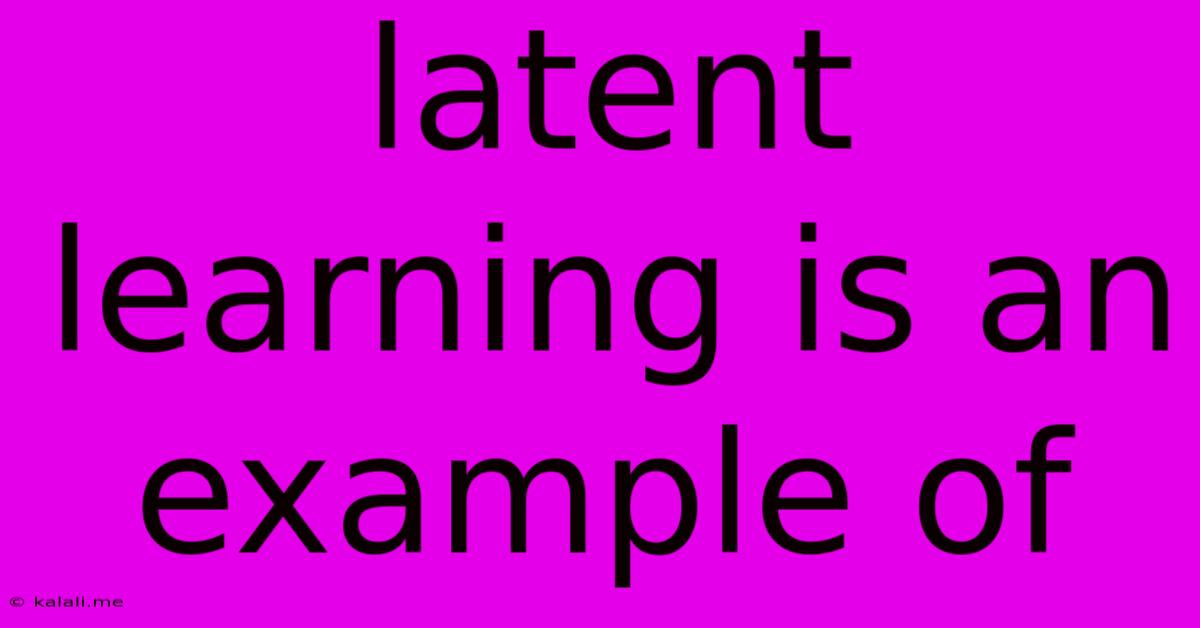Latent Learning Is An Example Of
Kalali
Jun 12, 2025 · 3 min read

Table of Contents
Latent Learning: An Example of Cognitive Processes Beyond Observable Behavior
Latent learning is a fascinating example of how much learning occurs beneath the surface, beyond what we can directly observe in an animal's or a person's behavior. It demonstrates that learning can happen without immediate reinforcement and only becomes evident when there's an incentive to demonstrate it. This challenges traditional behaviorist views that learning is solely dependent on observable responses to stimuli. This article will explore latent learning, providing examples and highlighting its implications for our understanding of cognition.
What is Latent Learning?
Latent learning refers to learning that occurs but is not immediately reflected in behavior. It's a type of implicit learning, meaning it's acquired unintentionally and without conscious effort. The learned information remains hidden until a situation arises where it's advantageous to use that knowledge. Think of it as acquiring information and storing it away for later use, even without immediate application. This contrasts with other types of learning where the new knowledge immediately translates into a behavioral change, such as through operant or classical conditioning.
Tolman's Experiment: A Classic Demonstration
Edward Tolman's famous experiment with rats navigating a maze is a cornerstone of latent learning research. Rats were divided into three groups:
- Group 1 (Reinforced): Received food rewards for navigating the maze. They quickly learned the route, showing a decrease in errors over time.
- Group 2 (Non-reinforced): Received no reward for completing the maze. They showed little improvement in their navigation skills.
- Group 3 (Latent Learning Group): Initially received no reward, but after several days of exploration, they started receiving food rewards.
The striking finding was that Group 3, upon receiving the reward, suddenly demonstrated a dramatic improvement in maze navigation, performing as well as or even better than Group 1. This showed that they had been learning the maze layout all along, even without any apparent motivation or reinforcement. The knowledge lay dormant (latent) until the introduction of the reward made it beneficial to express this learned information.
Examples of Latent Learning in Everyday Life:
Latent learning is not confined to laboratory settings; it's a pervasive aspect of human learning:
- Learning a new route: You might drive the same route to work every day without consciously memorizing the streets. But if your usual route is blocked, you might suddenly be able to find an alternative route based on your past passive observations.
- Acquiring a new language: You may absorb vocabulary and grammar rules simply by being exposed to the language through movies, music, or conversations, even without formal study. This latent knowledge might only become apparent when you start actively learning the language.
- Understanding complex concepts: You might passively listen to a lecture without consciously processing all the information. However, when you later encounter related material or have a need to use that knowledge, you might find you’ve retained far more than you initially realized.
Latent Learning and Cognitive Maps
Tolman argued that latent learning demonstrates the existence of cognitive maps – internal representations of the environment. Rats in his experiment were not simply learning a sequence of turns, but rather forming a mental map of the entire maze. This cognitive map remained latent until there was a reason to use it, showcasing the role of mental processes in learning.
Implications of Latent Learning
The discovery of latent learning has significant implications:
- Challenges behaviorism: It shows that learning is not solely a matter of stimulus-response associations, as behaviorism posits, but also involves internal mental processes.
- Highlights the importance of exploration: Simply exploring an environment can be a powerful learning experience, even without immediate reinforcement.
- Explains unexpected performance improvements: Sudden bursts of competence can sometimes be explained by latent learning, where prior, unobserved learning finally surfaces.
In conclusion, latent learning provides compelling evidence for the existence of cognitive processes that significantly impact learning, highlighting the complex interplay between experience, internal mental representations, and observable behavior. It serves as a reminder that much of our learning occurs implicitly and may only become apparent when the appropriate context and motivation arise.
Latest Posts
Latest Posts
-
What Is The Factor Of 102
Jun 13, 2025
-
How Many Megabytes Are In 1 Terabyte
Jun 13, 2025
-
How Many Molecules In One Mole Of Water
Jun 13, 2025
-
Polar Moment Of Inertia Of Rectangle
Jun 13, 2025
-
Ink Is To Paper As Paint Is To
Jun 13, 2025
Related Post
Thank you for visiting our website which covers about Latent Learning Is An Example Of . We hope the information provided has been useful to you. Feel free to contact us if you have any questions or need further assistance. See you next time and don't miss to bookmark.